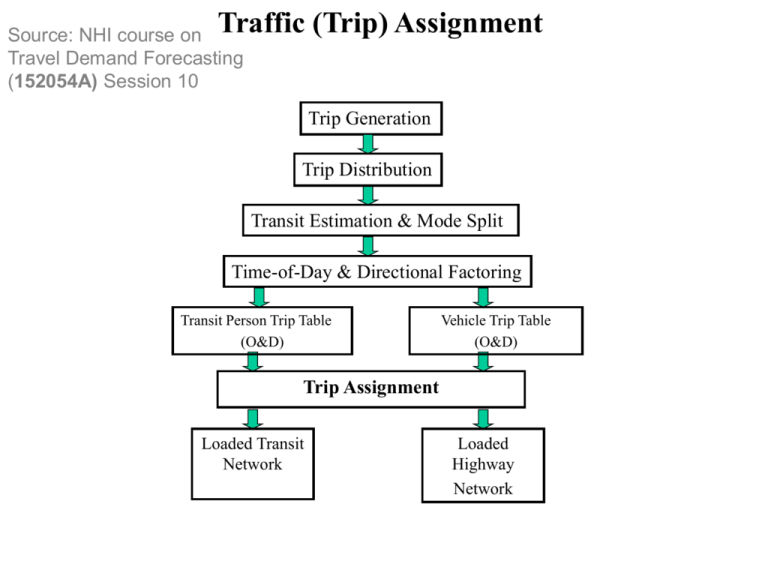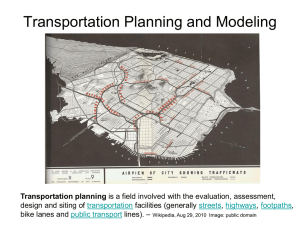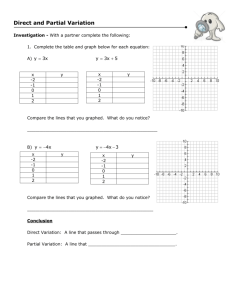Traffic Trip Assignment: Travel Demand Forecasting
advertisement

Source: NHI course on Traffic Travel Demand Forecasting (152054A) Session 10 (Trip) Assignment Trip Generation Trip Distribution Transit Estimation & Mode Split Time-of-Day & Directional Factoring Transit Person Trip Table (O&D) Vehicle Trip Table (O&D) Trip Assignment Loaded Transit Network Loaded Highway Network Review Trip Assignment Objectives: • Explain the concept of an all-or-nothing assignment • Explain the concept of an equilibrium assignment • Identify the BPR formula • Identify the source of the input data to the BPR formula • Explain the application of the BPR formula in an equilibrium assignment • Explain the meaning of the volumes from an all-or-nothing assignment • Explain the meaning of the volumes from an equilibrium assignment Terminology • Highway/trip assignment • Transit trip assignment • All-or-nothing assignment • Equilibrium assignment • Freeflow speed • • • • • Path finding Impedance Path loading Level of service Capacity restraint Inputs and Outputs Inputs • O&D trip table • Coded network Outputs • Link flows as per coded network • Link travel times/speeds • VMT • Vehicle hours of travel Trip Assignment Methods •All-or-nothing assignment •Equilibrium assignment (approximation!) •Transit assignment All-or-Nothing Assignment Step 1: Find Shortest route between the TAZs Step 2: Assign all trips to links compromising shortest route Advantages •Simple •Inexpensive •Results easy to understand Disadvantages •Assumes all traffic will travel on shortest path •Creates unrealistic flow patterns Step 3: Continue until trips between all TAZ pairs have been assigned (7) (8) (9) These results From this specification Logit model Can set Ui = -tti Can set Ui = 1/tti, but if you do, will need a calibration coefficient 67 24 9 Capacity Restraint • Volume-delay relationship • Average travel speed decreases with increased flow (volume) • Average travel time increases as the volume-to-capacity ratio on a link increases • The Bureau of Public Roads (BPR) formula, used as default in most model packages shows this relationship: Travel time depends on the loading, but the loading depends on the travel time – it’s an iterative process Alpha and beta can be calibrated for various link types and assumed LOS for capacity Source: Virginia Travel Demand Modeling Policies and Procedures Manual Equilibrium Assignment Step 1: Find shortest routes Step 2: Assign trips to shortest routes Step 3: Update link travel times using capacity restraint function Step 6: Average trips for last two assignments Step 5: Assign trips to shortest route Step 4: Compute now shortest routes using new travel times Step 7: Update link travel times using average trips assigned and capacity restraint function. Step 8 : Go back to Step 1. Step 9: Continue until volumes and travel times on links are in equilibrium •Utilizes the concept of capacity restraint (link impedance depends on link flow levels) •Assign traffic in congested networks so that no individual trip maker can reduce path costs by switching routes •Assumes trip makers know conditions on all routes. 10 100 12 16 13 12 100 16 11 14 Note: it is difficult to demonstrate the usefulness of this process in such a simplified network. Imagine thousands of links and OD pairs, and you could see how running this multiple times could produce various loads on the many links. In this and some other examples in this lecture, the loading pattern would simply repeat itself. 50 50 16 Average of the first two iteration’s loads, and resulting travel times Speed volume Why? Because speed doesn’t change much until you get close to capacity … the times and loads here are for demonstration purposes only. Note: 40% refers to 40% of the traffic between all OD pairs that use that link along their path. It may well be more or less than 40% of the capacity of the link itself. Re-compute these times with 67 and 33 trips, respectively Using Damping Factors to Control Oscillations By incorporating a damping factor you don't let the change in travel time between each iteration change so quickly. If the factor is, D = .5, then... instead of travel time changing from 7 to 12 minutes (change = 5), multiply change by .5, 5*.5 = 2.5, change travel time from 7 to 9.5 minutes. instead of travel time changing from 9.5 to 12 minutes (change = 2.5), multiply change by .5, 2.5*.5 = 1.25, change travel time from 9.5 to 10.75 minutes. 100 9.5 10.75 100 10 instead of travel time changing from 10 to 15 minutes (change = 5), multiply change by .5, 5*.5 = 2.5, change travel time from 10 to 12.5 minutes. 10.75 100 12.5 16 10 or 20 iterations or more may be needed in a real network 10.75 300/4=75 12.5 16 Re-compute these times with 75 and 25 trips, respectively 100/4=25 Older pseudo-equilibrium method (equilibrium approximation) This is not a true equilibrium method. It is a methods that was implemented in early models. TransCAD can do it, but it is not recommended Transit Assignment • Links include different services running between stops or stations. • Involves movement of passengers, not vehicles • Complex interchange patterns associated with passengers • Impedance functions includes fare structure • Some paths offer more than one parallel service with complex associated choices (e.g., express bus versus local bus service) Error Checking and Validation • Examine plotted trees • Compare counted VMT with modeled VMT • Compare external station counted volumes with modeled volumes. • Compare counted and modeled screen line volumes • Compare assigned volumes to ground counts for links grouped by facility type and by volume groups Some discussion on TransCAD • True EU and SUE assignment methods • Select Link Analysis – Zone/node based – Link based • Flow maps and v/c maps • Accounting for and optimizing signal operations • Combined trip dist/assignment method – feedback – Simultaneous modeling • Question: what would happen if we tested the shortest path from an O to a D following various types of assignments – All or nothing? Approximate methods? – Stochasting or SUE? (for this, need to know all used flow paths between the O and D … how to get?)






